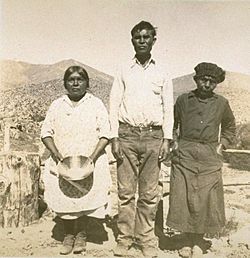Kawaiisu facts for kids

Kawaiisu Family
|
|
| Total population | |
|---|---|
| 2010: 60 alone and in combination | |
| Regions with significant populations | |
| Languages | |
| English, Tehachapi | |
| Religion | |
| traditional tribal religion | |
| Related ethnic groups | |
| Chemehuevi |
The Kawaiisu (pronounced: ″ka-wai-ah-soo″) are a Native Californian group. They have lived for a long time in the Tehachapi Mountains and nearby areas of California. Their traditional lands stretched from the Tehachapi Valley north towards Lake Isabella and Walker Pass. They also traveled east into parts of the northern Mojave Desert, including areas near the Antelope Valley and Death Valley. Today, some Kawaiisu people are part of the Tule River Indian Tribe.
Contents
Understanding the Kawaiisu Language
The Kawaiisu language, also called Tehachapi, is part of the Southern Numic division. This division belongs to the larger Uto-Aztecan language family. The Kawaiisu homeland was next to groups who spoke different Uto-Aztecan languages. For example, the Kitanemuk to the south spoke Takic. The Tübatulabal to the north spoke the Tübatulabal language, which is unique. The Yokuts to the west did not speak a Uto-Aztecan language at all.
The Chemehuevi people, who live to the east, are the closest language relatives to the Kawaiisu. This is because they also speak a Southern Numic language.
Names for the Kawaiisu People
The Kawaiisu have been known by several other names. These include Caliente, Paiute, Tehachapi Valley Indians, and Tehachapi Indians. However, they called themselves by names like Nuwu, New-wa, Nu-oo-ah, or Niwiwi. These names all mean "The People."
The names "Kawaiisu" or "Tehachapi Indians" came from the neighboring Yokuts people. Today, many Kawaiisu identify themselves as "Paiute". The term Nüwa ("People") is now commonly used by them and in the media.
Kawaiisu History and Lifestyle
Before Europeans arrived, the Kawaiisu lived in permanent villages during the winter. These villages usually had between 60 and 100 people. During the warmer months, they often split into smaller groups. They would gather native plants and hunt animals for food and materials. They lived in both the mountains and the deserts.
The Kawaiisu were divided into two main groups: the "Desert Kawaiisu" and the "Mountain Kawaiisu."
Connections to Other Groups
The Kawaiisu are connected to the Southern Paiute of Nevada and the Chemehuevi of California's eastern Mojave Desert. These connections are through their language and culture. It is thought that the Kawaiisu might have originally lived in the desert. They may have moved to the Tehachapi Mountains region as far back as 2,000 years ago or even earlier.
The Kawaiisu had good relationships with their neighbors, the Kitanemuk. They also worked with the Yokuts people, who lived in the San Joaquin Valley. For example, they would cooperate in hunting antelope. This involved driving herds of antelope into traps to make hunting easier.
Ancient Rock Art
The Numic-speaking peoples of this area are well-known for their amazing petroglyphs and Rock art. This includes the Kawaiisu, Timbisha/Panamint Shoshone, Southern Paiute, Owens Valley Paiute, and Coso people.
Preserving Kawaiisu Culture
In 2011, a group called The Kawaiisu Project received a special award. It was the Governor’s Historic Preservation Award. This award recognized their hard work in documenting the Kawaiisu language and culture. Their efforts included creating the "Handbook of the Kawaiisu" and teaching the language. They also established the Kawaiisu Language and Cultural Center and an exhibit at the Tehachapi Museum. A local newspaper noted in 2010 that there are "several hundred living Kawaiisu descendants," even though some people mistakenly believed they were all gone.
Kawaiisu Population Numbers
It is hard to know exactly how many native people lived in California before Europeans arrived. The numbers have changed a lot in different estimates. For example, a researcher named Alfred L. Kroeber suggested that the combined Kawaiisu population in 1770 was about 1,500 people. He estimated that by 1910, about 500 Kawaiisu people were still living.

